Article by Lee Escobedo // Sept. 06, 2018
After a minute or two of sitting in the Feeling Hole (2018), dug by artist and activist Nance Klehm in the courtyard of Ballroom Marfa, the yellow Texas sun begins washing visitors in heat and Vitamin D—a baptism devoid of dogma. It’s an invigorating experience, one hard to find in most exhibitions, as spectator becomes object and the soil canvas. First come the ants, crawling out of tiny holes to explore soft human flesh; moths arrive soon after, resting on cotton shirts and denim jeans; and if you’re truly lucky, the earthworms feel safe enough to emerge from their slumber, treating you as the prodigal child who has finally returned to Earth.
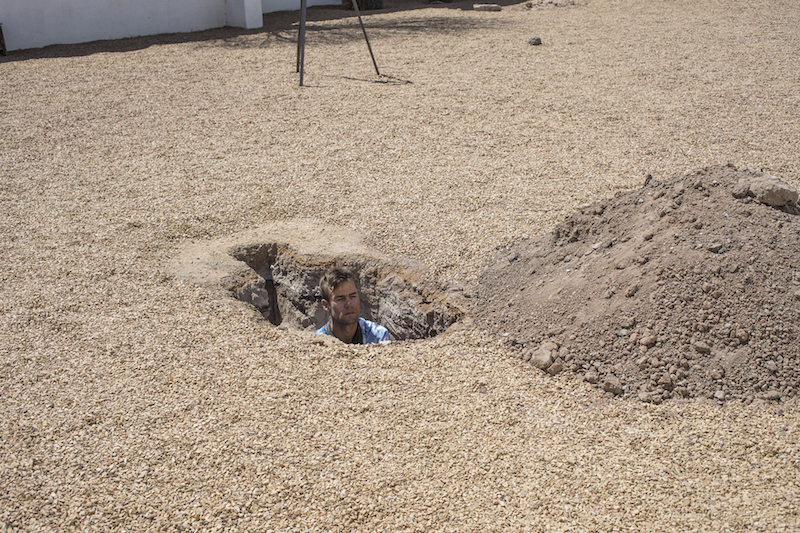
Installation view of ‘Hyperobjects’ at Ballroom Marfa, 2018 // Photo by Alex Marks
This experience is one of many at work within ‘Hyperobjects’ at Ballroom Marfa, an exhibition organized by the institution’s director and curator Laura Copelin alongside philosopher and professor Timothy Morton. In his 2013 book Hyperobjects: Philosophy and Ecology After the End of the World, Morton defines hyperobjects as ecological occurrences that are beyond the human capacity for understanding, such as global warming, styrofoam, nuclear waste and ocean pollution. Copelin then brings together interactive installations and non-art objects to present these philosophical abstractions in ways that they can become “re-seen.” Pulling from vast resources, including numerous artists, activists, the Sul Ross Herbarium, the Center for Big Bend Studies and the nearby McDonald Observatory, she gives the viewer a hands-on experience that helps adjust and reframe the scale of human perception. The hyper-local ecology of Marfa, Texas, a border-town desert filled with stark blue skies, voluptuous mountains and mystical wildlife, acts as microcosm for the Earth at large.
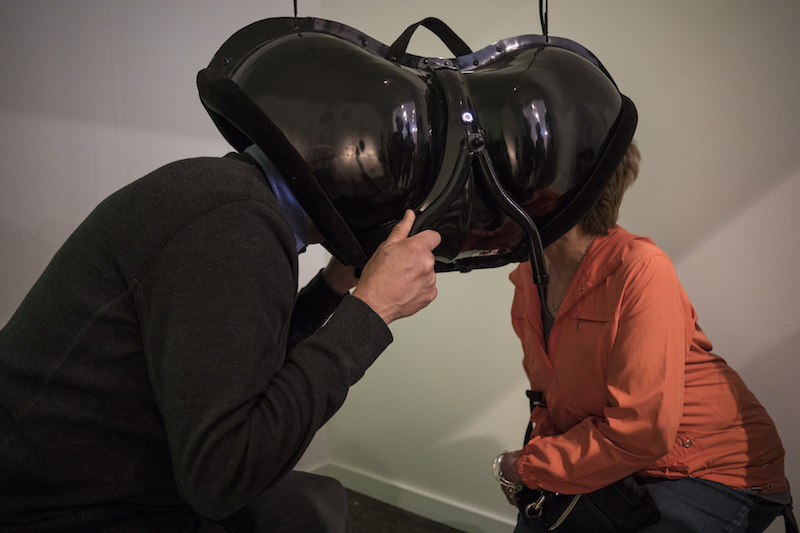
Installation view of ‘Hyperobjects’ at Ballroom Marfa, 2018 // Photo by Alex Marks
For Sissel Marie Tonn and Jonathan Reus’ The Intimate Earthquake Archive (2016–ongoing), guests are invited to put on vests, which swallow one’s upper body in their weight, and roam through the space’s courtyard. When approaching activation points, the vest emulates the effects of earthquakes caused by fracking in Groningen, a municipality in the Netherlands. The vest rattles its wearer’s bones and shakes into their guts, developing an inner sense of empathy for the Earth, whose agony we too often ignore. Mirrorbox (2014), by Mary May Daalder, also gives way to a metaphysical approach to destabilizing our egocentric modes of thinking. As two people place a set of conjoined helmets over their heads, they peer from opposite sides into a series of mirrors and lenses, which slowly merge their two faces into one. Like taking ayahuasca with your mortal enemy, this piece is intended for two people on opposing sides of ideological spectrums to experience together in hopes that they arrive on the other side with fewer answers.
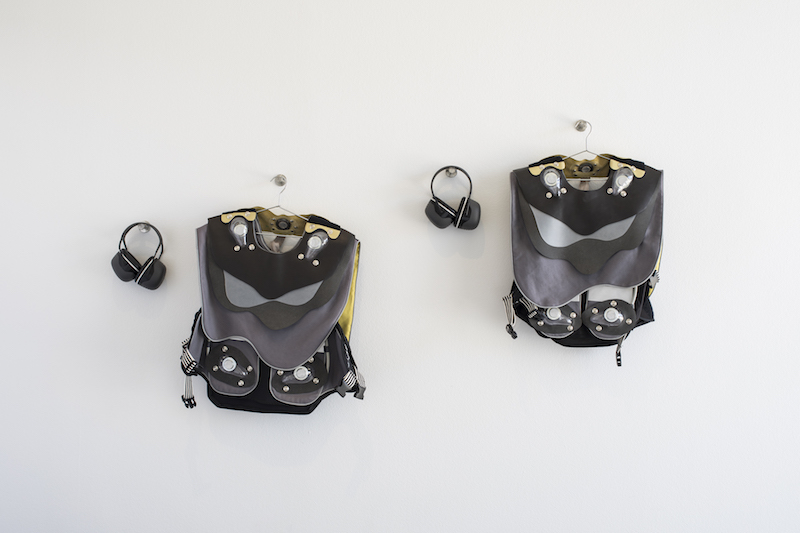
Installation view of ‘Hyperobjects’ at Ballroom Marfa, 2018 // Photo by Alex Marks
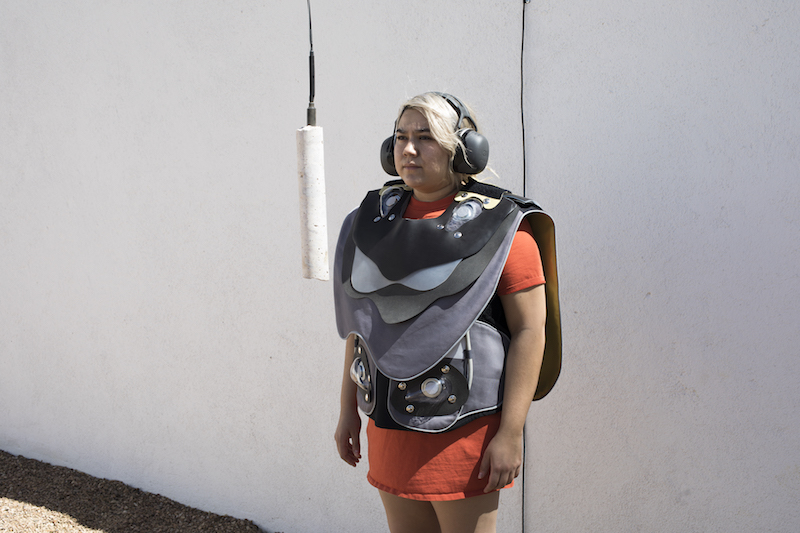
Installation view of ‘Hyperobjects’ at Ballroom Marfa, 2018 // Photo by Alex Marks
In her video work No Place Rising, Emilija Škarnulyté (2015) plays a mermaid archaeologist from the future. We watch as she glides with a prosthetic tail through oceanic steel machinery, which, viewed through her post-apocalyptic vision, become relics of a past, failed society—a warning that our technological developments might actually be our downfall. This idea of humankind’s tendency for fatalism translates in West Texas Flip, a haunting video by activist Sharon Wilson, who is part of the nonprofit Earthworks and dedicated to protecting the environment and promoting sustainable alternatives. Wilson and Earthworks use infrared technology to capture West Texan scenes of industrial pollution normally invisible to the naked eye and the effects of which won’t be wrought until years to come. They then assist residents to file complaints with regulators, but sometimes it’s too late. In the film’s most horrifying scene, a repair worker has climbed up to a gas well to work on the site, but what he can’t see, the camera shows: his body is immersed in clouds of toxic fumes.
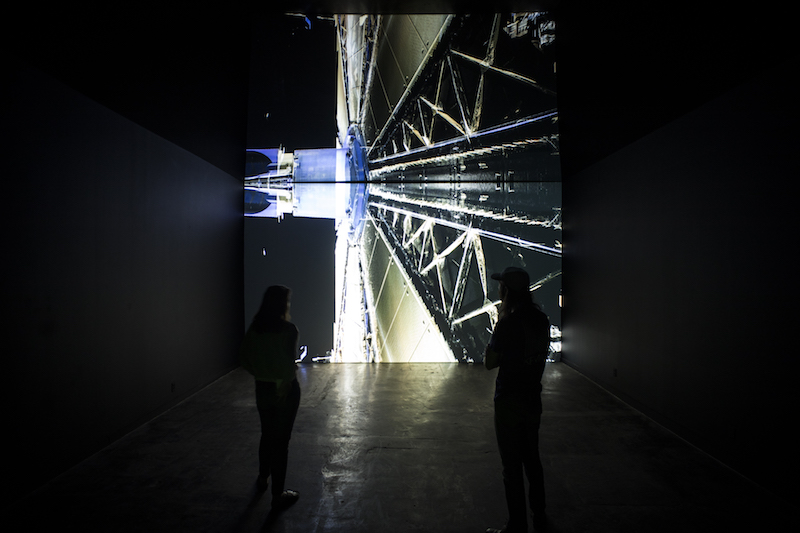
Installation view of ‘Hyperobjects’ at Ballroom Marfa, 2018 // Photo by Alex Marks
Although Wilson is a “non-artist,” West Texas Flip seamlessly fits into the theoretical dialogue Copelin and Morton are attempting to have with corporate developers in an effort to refocus their attention, or, at a minimum, to shed light on issues that are often difficult to comprehend. The exhibition makes clear that pace at which the earth reacts to our actions cannot be compared to that at which industrial capitalism escalates. ‘Hyperobjects’—both as a theory and exhibition—at least momentarily re-centers the visitor’s focus, who can carry the message into the rest of the world: it is time to slow down for a contemplative pause and to reverse and repair capitalist violence.
This article is part of our monthly topic of ‘Water.’ To read more from this topic, click here.
Exhibition Info
BALLROOM MARFA
Group Show: ‘Hyperobjects’
Exhibition: Apr. 13–Nov. 04, 2018
108 E San Antonio St, Marfa, TX 79843, USA, click here for map



















